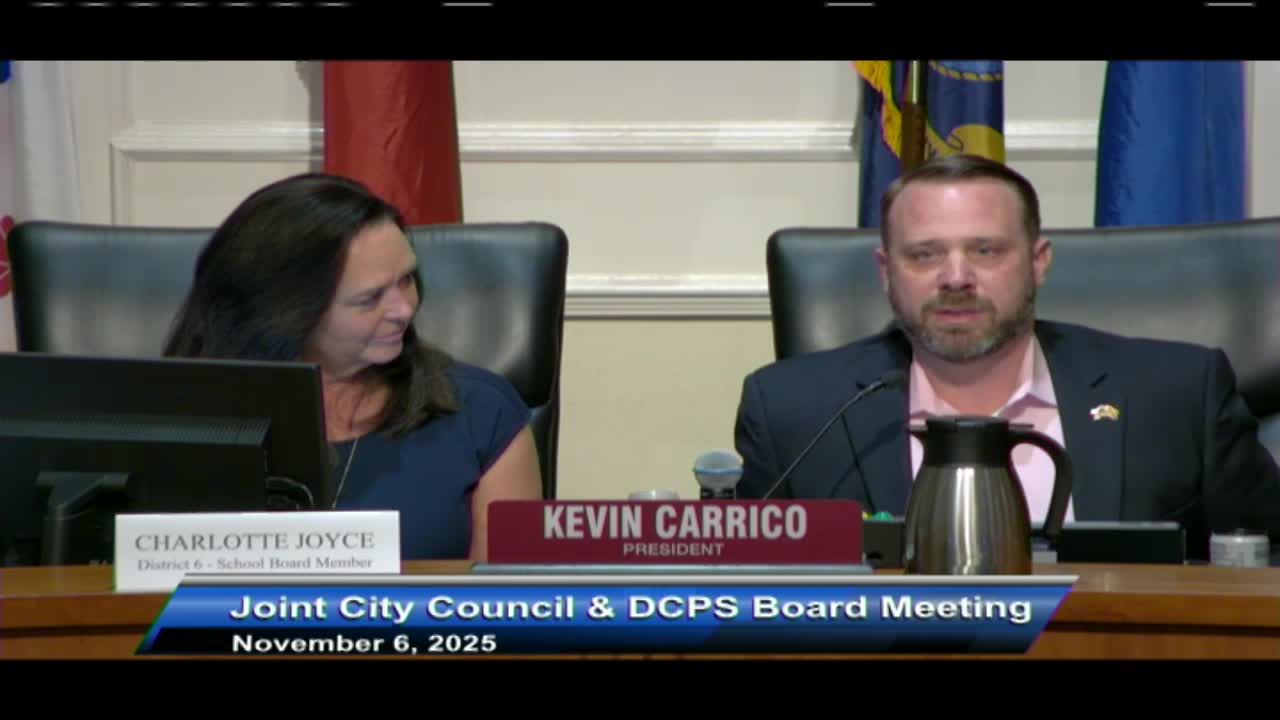Duval, city officials expand "Be Safe, Be Seen" safety push after multiple student pedestrian strikes; signal types and funding emerge as flashpoints
November 06, 2025 | Jacksonville, Duval County, Florida
This article was created by AI summarizing key points discussed. AI makes mistakes, so for full details and context, please refer to the video of the full meeting. Please report any errors so we can fix them. Report an error »

Duval County and City of Jacksonville officials used a joint meeting to relaunch and refine a citywide student-safety effort, highlighting education, on-campus visibility and infrastructure as complementary strategies to reduce pedestrian injuries.
"Last academic year we had 43 students struck as pedestrians and three of those were fatal," said Jackson Shaw, who introduced himself as chief of school police. "This academic year we are already at 10 students struck, two of those being fatal." Shaw emphasized that many incidents occur away from school property and said the district relies on partnerships with the Jacksonville Sheriff's Office and the city to respond with enforcement and engineering.
Dr. Heather Albritton, director of health and physical education for Duval County Public Schools, outlined the Be Safe, Be Seen campaign's three pillars: education (integrating safety lessons and student leadership), visibility (banners, PSAs and pledges) and engagement (coordination with PTAs, JSO, JFRD and community partners). She described traffic gardens as small simulated street environments where students practice crossings and decision-making without vehicle risk.
City traffic engineer Chris LeDoux described engineering options and policy thresholds. He said rectangular rapid-flashing beacons (RRFBs) can work on two-lane, lower-speed roads but that pedestrian hybrid/HAWK signals are more effective on multilane, higher-speed corridors because the HAWK provides a red indication that carries the force of law. LeDoux said the city will study policy updates and urged elected officials to include priority school-safety projects on the county/DOT project lists to secure state funding.
Commander Scott Lundquist (specialized patrol, JSO) said the sheriff's office currently staffs roughly 290 crossing guards and has about 325 openings; JSO is increasing traffic enforcement resources and evaluating speed-camera pilots. Council and board members raised concerns about crossing-guard recruiting and retention, the visibility of guards and whether reflective gear or flashing stop paddles would improve safety.
City staff and the school district described several near-term tools and process changes: a pilot sidewalk and speed-inventory database tied to school locations, a joint school-safety committee that meets monthly, and a recommendation that the district and council coordinate capital-prioritization lists for FDOT and the North Florida TPO. Several elected officials urged creation of a dedicated liaison or expedited workflow within public works for school-safety requests.
Why it matters: officials framed the problem as multi-jurisdictional (school district, city and state roads) and multimodal (walking, biking, drop-off queuing). The meeting ended with a pledge to convene a high-level follow-up — involving the mayor's office, council leadership and school executives — to accelerate prioritized school-safety projects before the next school year.
Speakers quoted in this article are identified in the meeting transcript.
"Last academic year we had 43 students struck as pedestrians and three of those were fatal," said Jackson Shaw, who introduced himself as chief of school police. "This academic year we are already at 10 students struck, two of those being fatal." Shaw emphasized that many incidents occur away from school property and said the district relies on partnerships with the Jacksonville Sheriff's Office and the city to respond with enforcement and engineering.
Dr. Heather Albritton, director of health and physical education for Duval County Public Schools, outlined the Be Safe, Be Seen campaign's three pillars: education (integrating safety lessons and student leadership), visibility (banners, PSAs and pledges) and engagement (coordination with PTAs, JSO, JFRD and community partners). She described traffic gardens as small simulated street environments where students practice crossings and decision-making without vehicle risk.
City traffic engineer Chris LeDoux described engineering options and policy thresholds. He said rectangular rapid-flashing beacons (RRFBs) can work on two-lane, lower-speed roads but that pedestrian hybrid/HAWK signals are more effective on multilane, higher-speed corridors because the HAWK provides a red indication that carries the force of law. LeDoux said the city will study policy updates and urged elected officials to include priority school-safety projects on the county/DOT project lists to secure state funding.
Commander Scott Lundquist (specialized patrol, JSO) said the sheriff's office currently staffs roughly 290 crossing guards and has about 325 openings; JSO is increasing traffic enforcement resources and evaluating speed-camera pilots. Council and board members raised concerns about crossing-guard recruiting and retention, the visibility of guards and whether reflective gear or flashing stop paddles would improve safety.
City staff and the school district described several near-term tools and process changes: a pilot sidewalk and speed-inventory database tied to school locations, a joint school-safety committee that meets monthly, and a recommendation that the district and council coordinate capital-prioritization lists for FDOT and the North Florida TPO. Several elected officials urged creation of a dedicated liaison or expedited workflow within public works for school-safety requests.
Why it matters: officials framed the problem as multi-jurisdictional (school district, city and state roads) and multimodal (walking, biking, drop-off queuing). The meeting ended with a pledge to convene a high-level follow-up — involving the mayor's office, council leadership and school executives — to accelerate prioritized school-safety projects before the next school year.
Speakers quoted in this article are identified in the meeting transcript.
View full meeting
This article is based on a recent meeting—watch the full video and explore the complete transcript for deeper insights into the discussion.
View full meeting